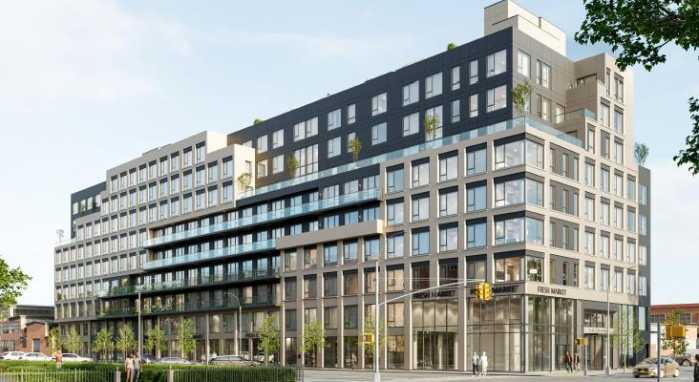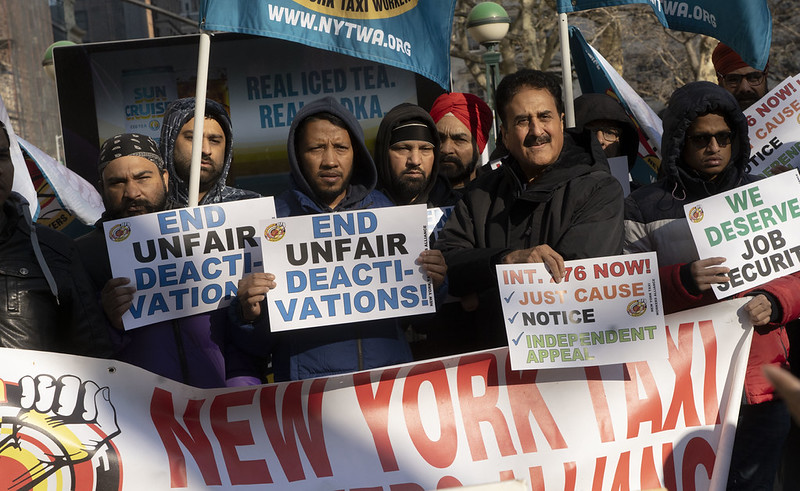The Astoria World Manor’s ballroom was at full capacity on Thursday, with most attendees there to hear the proposed plans for a new mixed-use building on 22-60 46th St. — and Community Board 1’s advisory decision about the project.
There was no shortage of passionate discourse throughout the evening from both the board members and residents of Astoria.
During the public statement portion of the meeting, there seemed to be a split feeling among those who spoke about what the project would mean for the historically residential neighborhood — with some feeling that it would “destroy the neighborhood’s character” and others believing it will bring new life to it.
Before board members had a chance to question the project’s details and the Astoria residents expressed their concerns or support, representatives of Mega Contracting Inc. explained what the project would entail.
Project details
Mega Contracting, along with its administrating agent HANAC, Inc., wants to begin developing an eight-story building in the spring of 2020. The mixed-use building, with a proposed rezoning from R4 to R6, will have two sections: a base with a parking garage and a community theater and the upper tier for residential use with 88 total units.
The units will be made up of one-, two-, and three-bedroom apartments — 60 percent of those would be two- and three-family units.
A two-bedroom apartment, for instance, would cost roughly $3,500 per month, according to the Mega Contracting rep.
It will also include a 6,300 square feet of commercial space along 45th Street.
They will also have 28 affordable housing units required by law, with 18 of them at 135 percent of theAstoria’s Area Median Income (AMI) — meaning “most of the units that are required to be affordable will be greater than the AMI,” according to CB member, Evie Hantzopolous, chairperson of the Housing Committee.
According to the Mega Contracting reps, they want the building to be “family-friendly” and mostly affordable for middle class families, based on their findings of Astoria’s AMI.
Additionally, the building will provide the Pancyprian Association, a community organization focused on “protecting and assisting the struggle of the Cypriot people for freedom and justice,” with a permanent home for their art-related and community-outreach endeavors.
The Mega Contracting reps also mentioned that the 250-seat theater will be available to other cultural groups.
There will also be a public space with benches for the public to use.
CB1 voted against the application, unless certain conditions were met
Hantzopoulos had several questions about the affordability of the project, adding that she didn’t “think this is affordable at all” and that even middle income folks would be “priced out.”
Longtime board member Rodolfo Sarchese gave a prepared speech, urging his fellow members to vote against the project.
“I believe I may be the only board member that lives close to this project,” he said. “This will not only change the character of the neighborhood, but will destroy the residential hub.”
He added that the signatures from petitions that Mega Contracting was using in favor of the new building were mainly from people who didn’t live near the area.
Other board members were afraid that the additional residents and size of the building would hurt the sewer system and other infrastructures in the area.
In the end — after some confusion from board members regarding the motion — the board voted in favor of the Land Use and Zoning Committee’s motion to disapprove the application unless certain conditions were met, including:
- To “reduce the height of the building to reflect the surrounding residential context and excluding the Pistilli building from being considered as contextual.”
- That the “height in set back of the front wall should not exceed six stories with no penetration to the street wall.”
- They support: the 30 percent of the AMI proposed by Mega Contracting.
- They “do not want the workforce proposal (30 percent of the square footage).”
- To “limit the number of units to no more than 88.”
- To keep units as “no studios, 40 percent one-bedroom, 42 percent two-bedroom and 18 percent three-bedroom as outlined in the applicants letter.”
- For their open space, to “provide landscaped areas for public use and passive open space.”
- For the parking garage, to increase “number of spaces within the building … and also to provide discounted rates for the tenants as well as validation for any attendees of the theater performances.”
- For the theater use, to “support limiting the theater use and rentals of the theater to nonprofit community and cultural groups.”
The reaction from the public at the meeting was mixed, but intense
Tensions were high throughout the evening, as several attendees yelled over each other and interjected claps, cheers, and the occasional derogatory words throughout the different public statements.
Al Rizzo, a long time member of Astoria and a member of the Astoria Homeowners Association, brought up concerns of increased traffic in the already heavily used Ditmars.
“Piece by piece, developers are destroying whole neighborhoods,” Rizzo said. “It begins with one project, and others follow. Quiet, residential neighborhoods are now being overpopulated by big developers, these neighborhoods lack the infrastructure, they lack the adequate transportation to carry the increase population in traffic.
Philip Christopher, president of the Pancyprian Association and a born-and-raised Astoria resident said that 80 percent of the Pancyprian Association’s members were from Astoria and would never hurt the neighborhood.
“The American dream is about organizations like us that keep the people together, that keep our young kids in the dance groups, in the theater, in the soccer teams,” Christopher said. “Let me tell you, if it was not good for this community, I would be against it too.”
Two members of the Astoria Homeowners, Tenants and Business Civic Association — President Tony Mazzara and Chair Luigi Farina — also gave public statements. They said they surveyed their members and found that 95 percent of them were against the proposed new building.
“The concerns were regarding the bus rides, infrastructure, sewer system and electrical [impact],” Mazzara said.
Frank, a 61-year-old longtime resident of Astoria, is for the new establishment, telling his story about growing up “dirt poor” and now owning “four houses” within 1,000 feet of the proposed location of the building.
“For 40 years, I’ve been looking at a graffiti building and now I’m looking at hypodermic needles, and it’s really sad, very sad,” he said. “And I’m for this project, and I would never, ever do anything to hurt Astoria. Never. I love Astoria.”
Another life-long resident of the neighborhood, John Cilanto, disagreed.
“It’s a community of homeowners, not gigantic apartment houses, and your misleading diagram doesn’t help,” Cilanto said, referring to the graphics Mega Contracting presented. “It should not be in a residential community of small homes, and there are other options for any organization that needs space, you don’t have to build an eight story apartment house to have a meeting hall.”
Joanna, a teacher who’s lived her whole life in Ditmars and teaches in Astoria, gave a prepared statement about the positive effect the residential and theater building would have on the community.
“As an educator that works and lives in the same community, the zoned school where this development is being built, and which I went to as an elementary student, is under-utilized and has had a decrease in student population,” she said. “Declines like this can ultimately lead to school closure and an influx of students attending other schools in the area.”
She added, “More families moving into residential development like this will increase enrollment, save teaching jobs and will ultimately benefit an already struggling school system.”
Another resident — a mother who has lived in Astoria for 22 years — received the most cheers of the night when she talked about her confusion surrounding the development.
“So are we building the building for the theater or the theater for the building? Because this doesn’t make sense to me” she asked, receiving a wave of applause from the audience. “For four times a year, you guys want to take over a whole neighborhood, a whole entire neighborhood.”
She added that the “free” Queens Theater could be place for cultural organizations to host their shows.
“We cannot live on Ditmars any longer because of the traffic, OK? My kids can’t walk around because of the traffic, it’s dangerous,” she added. “If you want to build something, build it small — three family. But these guys all want to make the money.”




































